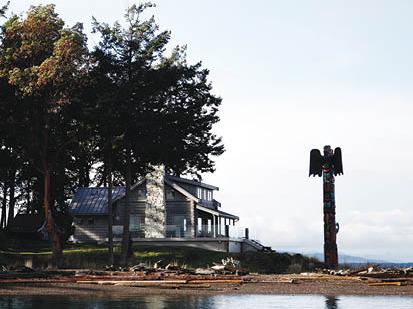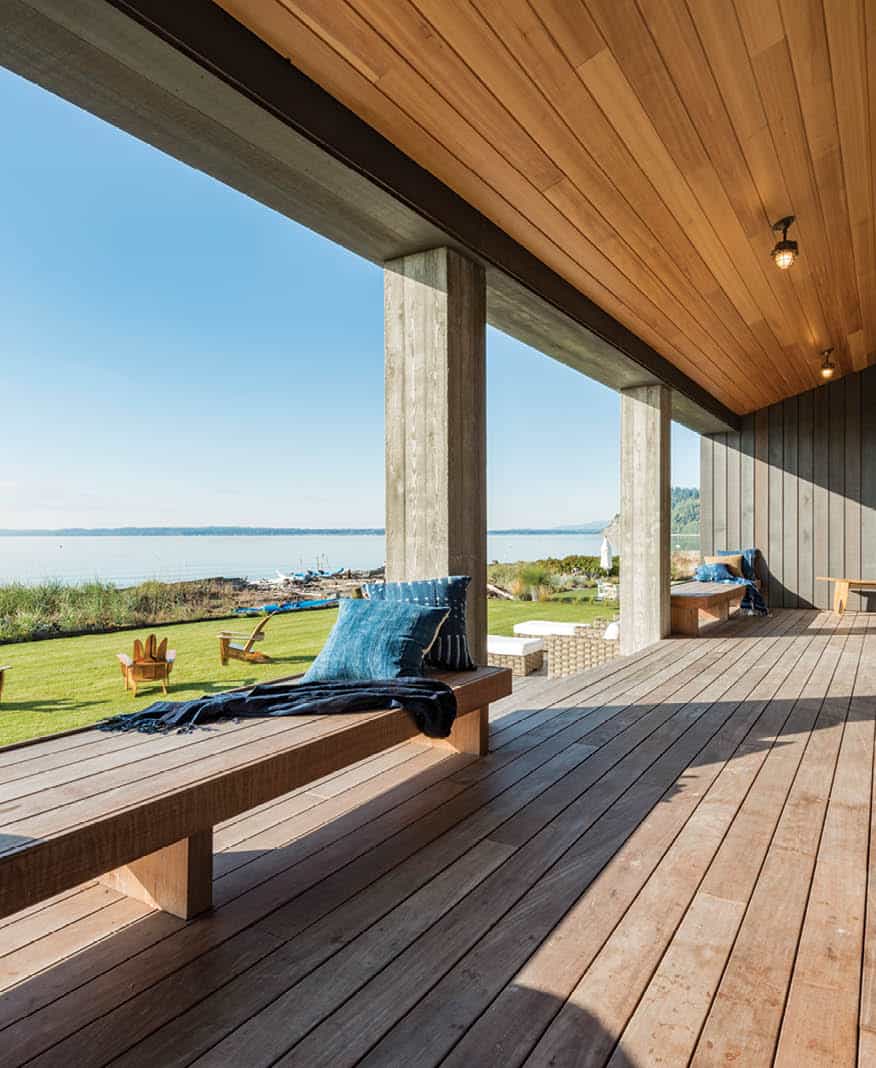With water all around Washington, these shoreline homes have plenty to offer
written by Melissa Dalton
A quick glance at a map shows the distance between Washington’s northern tip at Neah Bay and southern boundary at the Columbia River is less than 200 miles. But once you account for the many islands, sounds, bays and rivers, the official coastline length increases to a whopping 3,026 miles of secluded beaches, tree-lined inlets, bustling ports and small fishing communities set at the water’s edge. We’re peeking inside three stellar coastal homes that celebrate the state’s coastal riches.
A Family Destination in Useless Bay
Don’t ask John Zevenbergen if his family is into watersports—a better question might be whether there’s anything they don’t like to do in the bay. “We water ski, scuba dive, go skimboarding and fishing,” Zevenbergen said. Crabbing, windsurfing, sailing, swimming and paddling are also popular pastimes. “Between us we pretty much have a flotilla of boats,” Zevenbergen said. The family’s favorite spot for their pursuits is Useless Bay, which sits across the Puget Sound from Edmonds, where Zevenbergen grew up. “My family always had a place on Useless Bay,” Zevenbergen said.

His parents bought property there almost sixty years ago, and Zevenbergen continued the tradition in 1995 when he bought his first cabin. As his own family expanded with children and grandchildren, he bought the neighboring home in 2012, then promptly contacted the architects at Hoedemaker Pfeiffer for a renovation plan. As the project progressed, it made sense to replace the two cabins with one larger home, so anywhere from two to twenty people could be under one roof. Of course, easy access to the water was paramount. “They were looking for something that would allow them to use the property as a base for all of their indoor and outdoor activities year-round,” architect Steve Hoedemaker said.
Useless Bay earned its name around 1841 when the Wilkes Expedition observed its “exposure to storms.” Zevenbergen has seen those squalls up close. “In the winter, there’s so much wind that the waves hit the beach and spray saltwater right on the house,” Zevenbergen said. “The rain blows so hard and so consistently that it goes vertical up the wall.” To address this, the new construction prioritized durability. For the foundation, builder Heggenes Construction propped the home atop concrete piers sunk more than 50 feet into the ground to minimize potential flood damage when the water swells. The exterior received reverse board and batten siding, aluminum-clad windows and a zinc roof and gutter system, with a porch made of hard-wearing Ipe wood.
Inside, the architects applied a restrained palette with rigorous consistency. Wood, concrete, marble and brass deliver a streamlined approach to the classic beach cabin aesthetic. Lightly whitewashed custom-milled spruce wraps the walls and polished concrete covers the floor. Marble slabs line the kitchen counters, inset buffets and appear on bathroom vanities. Brass bedecks cabinet pulls and bedroom lighting, and is also found underfoot as decorative seams in the concrete.
For the layout, bedroom wings flank a central great room. On one side is the principle suite—on the other, several bedrooms with en-suite baths. Thus, the home can accommodate a couple for a weekend, or more for a bigger family shindig. “One of the things that we always like to do is create experiences that allow people to forget about their urban existence and reminders of the work week,” Hoedemaker said. To that end, the central room has a wall of glass doors and windows that frame the view. This ensures the home will always connect Zevenbergen’s family to the bay, whether they’re storm-watching or fueling up for their next episode on the water.
Art in a Historic Oysterville Home

There is a bench in Oysterville engraved with a quote from Willard R. Espy, an American writer who grew up in the Long Beach Peninsula town. The quote reads, “I can watch the slow breathing of the bay, six hours in and six hours out.” For architect Ralph Christensen, the words capture the vibe of the historic walking village on Willapa Bay. “It’s really about a different kind of time there, dictated by the tide, weather and natural rhythms,” Christensen said. “That’s what makes it special.”
In 2013, Christensen and his partner, Barb, both of the studio Res Loci, were approached to renovate Oysterville’s Captain Stream House, which had been built around 1869. Oysterville was one of the earliest settlements in coastal Washington and so named for its booming oyster farming industry in the mid-1800s. The Captain Stream House sits within the historic district and joined the National Register of Historic Places in 1976. Its owners, Martie Kilmer and husband Steven Romero, sought to preserve the house’s historical significance, while also updating it for the future.
It’s really about a different kind of time there, dictated by the tide, weather and natural rhythms. That’s what makes it special.
—Ralph Christensen, architect

Their team, including the Christensens and contractor Mack Brothers and Sons, started by meticulously restoring the front façade, then bumped out the rear just a few feet to accommodate fluid, open living on the main floor and a much-needed principle suite upstairs. “Our house didn’t really have a bathroom before,” Kilmer said. “We would streak from the back porch to the garage to take a shower.”
At the rear of the property, the group built a pass-through garage with a two-bedroom guest apartment above it. There’s also a ceramics workshop and extensive garden, just steps away from the main house’s back door. With this approach, the smaller footprint of the original Captain Stream House remains intact, but the property can flex with the couple’s needs. Christensen appreciates how the setup fits the village’s architectural past: “The spirit of Oysterville was always an amalgamation of small buildings. People would have their house, a garage, a shed for tools, and a chicken coop and outhouse,” Christensen said. “It’s very much that compound effect of multiple buildings rather than one big building which holds everything.”
Throughout the interiors, art and craft seamlessly mix thanks to Kilmer’s vision and the artists she’s befriended through her work as a stylist and designer. Brooks Woodworks fabricated the walnut kitchen cabinetry, as well as the custom dining table and benches. Emily Bixler knotted a crocheted curtain over the freestanding tub upstairs, while Doug Johnston wove the rope pendant lights over the dining table. “There’s nothing that’s really mass-produced,” Kilmer said.
Thanks to Kilmer and Romero’s efforts, the Captain Stream House now effortlessly reflects the slower pace in Oysterville and time spent walking, cooking homegrown meals and making art. “When you’re driving from the big city, there’s this turnoff on Sandridge Road,” Kilmer said. “The second that we make that turn, my shoulders drop and the air changes and I get really relaxed. I still can’t believe that I get to live here.”
A Log Cabin Respite on Henry Island

Kristina Gladstein’s log cabin on Henry Island was not always as serene as it looks today. When she first stepped inside the 1950s-era building, it had no electricity, no running water and a “pseudo-bathroom” that consisted of a composting toilet and little else. The logs themselves were almost black from age and smoke damage, which made the interior gloomy, as well as dysfunctional. “It just looked so dark and ominous in there,” Gladstein said. She wondered whether she should save the structure, or tear it down and build anew.
The first step was to determine if the wood was salvageable. Gladstein tried pressure-washing, with little success. When applying a coat of white-wash didn’t help either, she bought a few cans of white paint. “Everybody told me that they thought it was a terrible idea,” Gladstein said, but the outcome was a game changer. “Once I saw the logs painted white, we knew that we were going to keep it,” Gladstein said. “I was in awe of the transformation.” She then teamed up with local contractor Tom Nolan to rehab the rest of the home in a multi-year process that included treating the exterior, installing mechanical systems and a new roof, and adding two bathrooms, a mudroom and laundry. Two years into the renovation, Gladstein approached Lisa Staton of Lisa Staton Interior Design to help pull everything together.

The resulting cabin retains its utilitarian spirit. At the heart, a combination kitchen and dining room is ready for family meal prep, with copious counters and an island laden with accessible cookware. “It’s intended to be very easy to collaboratively cook and feast and relax,” Staton said. In order to prevent appliances from dominating the scheme, Staton located the refrigerator in an adjacent pantry. “It changes the way you experience the kitchen,” Staton said. “It helps it feel more furniture-like and integrated into the living space.”
At the top of Gladstein’s punch list was to let the cabin embrace its waterside setting. “The goal was for it to feel like a retreat deeply rooted in nature,” Staton said. Now, big picture windows overlook Haro Strait and salvaged materials pop up throughout the interior. In the living room, the original stone fireplace joins wide plank floors in reclaimed wood and a live-edge coffee table carved by a local artist. The contractor fashioned a bathroom vanity by sinking a basin into a thick chunk of wood. The kids room upstairs features bed frames formed from old fence corral posts. “It shows how you don’t need precious materials for good design,” Staton said.
Henry Island is the westernmost island in the San Juan archipelago. With no ferry service and limited cell reception, it’s an ideal retreat from our increasingly technology-crazed world. Gladstein’s cabin offers an “opportunity for restfulness, mindfulness and togetherness that is getting harder to happen,” Staton said. The cabin’s pull was such that after wrapping the project in 2017, Gladstein relocated her family from Seattle to nearby Friday Harbor to adopt full-time island life. “After we did this project, we realized that we couldn’t go back to the city,” Gladstein said.







